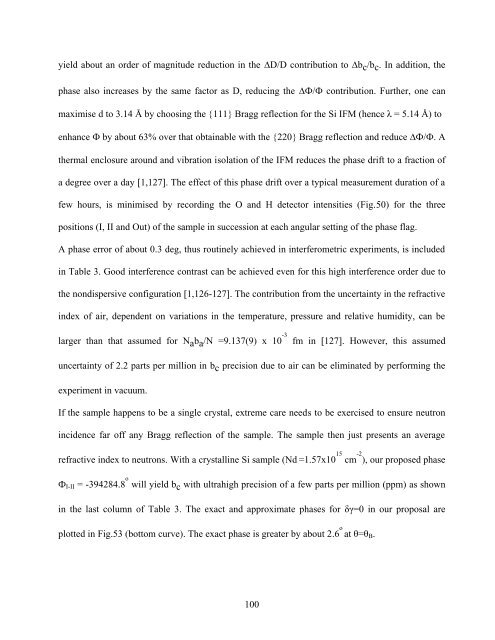PHYS01200804001 Sohrab Abbas - Homi Bhabha National Institute
PHYS01200804001 Sohrab Abbas - Homi Bhabha National Institute
PHYS01200804001 Sohrab Abbas - Homi Bhabha National Institute
You also want an ePaper? Increase the reach of your titles
YUMPU automatically turns print PDFs into web optimized ePapers that Google loves.
yield about an order of magnitude reduction in the D/D contribution to b c /b c . In addition, the<br />
phase also increases by the same factor as D, reducing the Ф/ contribution. Further, one can<br />
maximise d to 3.14 Å by choosing the {111} Bragg reflection for the Si IFM (hence λ = 5.14 Å) to<br />
enhance by about 63% over that obtainable with the {220} Bragg reflection and reduce Ф/. A<br />
thermal enclosure around and vibration isolation of the IFM reduces the phase drift to a fraction of<br />
a degree over a day [1,127]. The effect of this phase drift over a typical measurement duration of a<br />
few hours, is minimised by recording the O and H detector intensities (Fig.50) for the three<br />
positions (I, II and Out) of the sample in succession at each angular setting of the phase flag.<br />
A phase error of about 0.3 deg, thus routinely achieved in interferometric experiments, is included<br />
in Table 3. Good interference contrast can be achieved even for this high interference order due to<br />
the nondispersive configuration [1,126-127]. The contribution from the uncertainty in the refractive<br />
index of air, dependent on variations in the temperature, pressure and relative humidity, can be<br />
larger than that assumed for N a b a /N =9.137(9) x 10 -3<br />
fm in [127]. However, this assumed<br />
uncertainty of 2.2 parts per million in b c precision due to air can be eliminated by performing the<br />
experiment in vacuum.<br />
If the sample happens to be a single crystal, extreme care needs to be exercised to ensure neutron<br />
incidence far off any Bragg reflection of the sample. The sample then just presents an average<br />
refractive index to neutrons. With a crystalline Si sample (Nd =1.57x10 15 cm -2 ), our proposed phase<br />
Ф I-II = -394284.8 o will yield b c with ultrahigh precision of a few parts per million (ppm) as shown<br />
in the last column of Table 3. The exact and approximate phases for δγ=0 in our proposal are<br />
plotted in Fig.53 (bottom curve). The exact phase is greater by about 2.6 o at θ=θ B .<br />
100
















